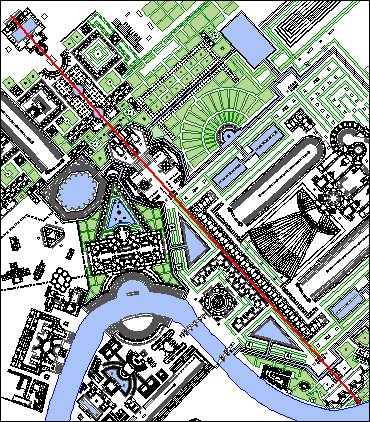Mars (Martis)
1998.07.23
The second temple of Mars, positioned on the west side of the Tiber at the foot of the Vatican Hill, sits within a hexagonal area labeled Apparatorium Triumphatorum -- the place of preparation for the triumphal march. In front of the temple and place of preparation is the decagonal Area Martis, which an euripus (canal/moat) encloses on two sides, and it is here that Piranesi indicates the beginning of the Triumphal Way. Besides the obvious ceremonial importance of the Area Martis, this place is also distinct within the Ichnographia: its ten-sided perimeter is the only such shape throughout the entire large plan. Significant also is the plan of the Templum Martis, whose ichnography resembles male genitalia. The deliberate connection between Mars and overt masculinity is unquestionable. Moreover, the Templum Martis, the Area Martis, and the beginning of the Triumphal Way together establish a principal axis, one of the three major axes present within the Ichnographia. This axis extends from the top of the Vatican Hill straight down to the bank of the Tiber across from the tomb of Augustus, and is not only great in length, but also rich in symbolism. Represented here is the mighty thrust of Mars, the dominance of Romulus, and hence the source of Rome and its unparalleled pride.

| |

The Templum Martis (top) is surrounded by a hexagonal place reserved for the preparation of the triumphal march. The Area Martis (below) is a large space in front of the Templum Martis and the place where the Triumphal Way begins (indicated in red).
The long axis running through the Templum and Area Martis (center) extends from the Nympheum Neronis atop the Vatican Hill (upper left) down to another Nymphaeum on the west bank of the Tiber (lower right).
|
| |
Re: more news from Philadelphia's Logan Circle
2003.09.12 10:40
I returned to the Benjamin Franklin Parkway to continue virtually walking along the Campo Marzio long axis from Hadrian's Tomb to the tiny 'intercourse' building along the banks of the Tiber.
The most thought/memory provoking Memorial around Logan Circle is the one dedicated to the Colored Soldiers" who fought in World War I. Remember, the Parkway was executed between the two World Wars. There it is, literally etched in stone, the description of "Colored". Otherwise, it is a very handsome memorial, and evokes an enormous amount of respect.
I am somewhat surprised at the predominate amount of military/soldier memorials within/along the Benjamin Franklin Parkway, and I can't help but see how this all relates perfectly to the Campo Marzio, since the original Field of Mars is exactly were ancient Roman soldiers used to exercise. I [re]read the other night, in Building The City Beautiful: The Benjamin Franklin Parkway and the Philadelphia Museum of Art, how the site of the Parkway, after demolition of the many previously occupied city blocks but before ultimate construction, was used briefly by troops before going to battle in Europe.
Lots of pictures were taken at and around Logan Circle before walking the rest of the axis toward the LOVE sculpture at JFK Plaza (now popularly referred to as "Love Park"). This part of the Parkway is integral to the city proper, thus tall buildings and regular pedestrians (half using cell phones) are in abundance--this contrasts with the Parkway north of Logan Circle, which is several large blocks of mostly open lawn. Just before reaching JFK Plaza, there is the Memorial dedicated to Holocaust Victims, on the Parkway since 1964. In the warmer months, the whole length of the Parkway (on both sides) is lined with the flags of the all the nations of the world--I believe this was started in the late 1970s. The nations are presented in alphabetical order, except the flag of Israel is next to the Holocaust Memorial, just like the flag of the Vatican is next to the Basilica of Sts. Peter and Paul.
John F. Kennedy Plaza/Love Park is one of Philadelphia's 'living rooms', and the Robert Indiana LOVE sculpture has been there (I believe) since the Bicentennial/1976. At first just a temporary installation signifying the meaning of Philadelphia--City of Brotherly Love, the sculpture became an endeared feature of the city and was thus made permanent. When I first took pictures of LOVE in October 2001, a newly engaged couple asked me to take a picture of them in front of the sculpture--the resultant picture was to be part of their Engagement Announcement. During the 1990s, Love Park became notorious as a preferred venue for skateboaders [indeed actually famous in overall skateboarding folklore]. Lots of damage was done, and skateboarding here is now prohibited--although I think special/official skateboarding competitions are still conducted here.
|